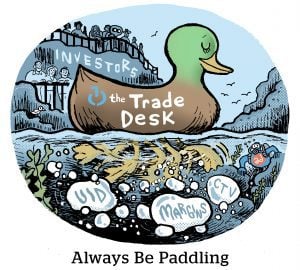The Trade Desk delivered another smash earnings report. What’s new?
The company’s total revenue in Q1 was $491 million, a 28% increase from last year, and net income (i.e., profit) jumped from $9 million in Q1 2023 to $32 million this quarter.
Consistent revenue growth and profit has become the norm for TTD, which reported on Wednesday. But Q1 2023 was a standout quarter primarily because the company’s profitability dipped so close to even.
What was new this time was The Trade Desk’s focus beyond the overall “open internet” and on what CEO Jeff Green called the “premium internet.”
From open to premium
The Trade Desk has always positioned itself as a champion of the open internet – to the point that, for years, the company didn’t publicly criticize made-for-arbitrage sites and ads (which it quietly blocked), because those sites are part of the open internet.
Now, TTD is drawing a distinction between spammy content on the open web – which is getting distribution via the walled gardens – and “the best of the open internet,” Green said, aka the premium internet.
He pointed to growing awareness of the “role that walled gardens are playing as major purveyors of low-grade, made-for-advertising inventory.”
Green also noted a “much wider understanding of bad ad-to-content ratios within walled gardens and the brand suitability risk of user-generated content.”
Although the walled gardens remain black boxes, advertisers and ad tech businesses have a little more visibility these days due to Big Tech litigation and regulations.
“The details of the Texas Attorney General’s suit against Google and the approaching trial of the Department of Justice versus Google have shined a light on a few themes inside of Google,” Green said.
Attribution or house of cards?
One major theme, according to Green, is that, although the walled garden platforms make ad attribution very easy, advertisers have no clear sense of where their ads were served or what results the campaigns drive for their business.
Because walled platforms have billions of users and a nearly endless supply of user-generated content, they’re able to produce relatively cheap reach.
“When you contrast that to premium content, it can seem very cheap, especially when you’re relying on the metrics that are provided by the companies that are selling you the inventory,” Green said.
The ad-to-content ratio across walled gardens is also through the roof. And not just because Google, Meta and Amazon are stuffing more ads into their own feeds. Another big problem is that these platforms also serve ads into cluttered, user-unfriendly environments on the open web.
The MFA phenomenon – spammy sites that syphon ad revenue while providing near zero value to readers or advertisers – is powered by walled gardens, although it’s a stain associated with open programmatic.
YouTube and the Google Search feed are stuffed with ads. Meanwhile, the Google ad network commonly drives traffic to MFA sites rather than the “premium” internet where, Green said, third-party programmatic tech like The Trade Desk typically operates.
Green contrasted someone watching Disney+ or listening to their favorite podcast with a person half-paying attention while scrolling quick-hit videos on Instagram or YouTube.
Where walled gardens excel isn’t quality or even ROAS, he said. It’s attribution.
“Walled gardens still command the bulk of digital advertising spend because those tech giants have made it super easy to reach consumers at mass scale,” Green said, “and the performance results are equally simplified. ‘Hey, look, your ads did great. We told you so, so it must be true.’”
But finally, he said, “that’s changing.”
















